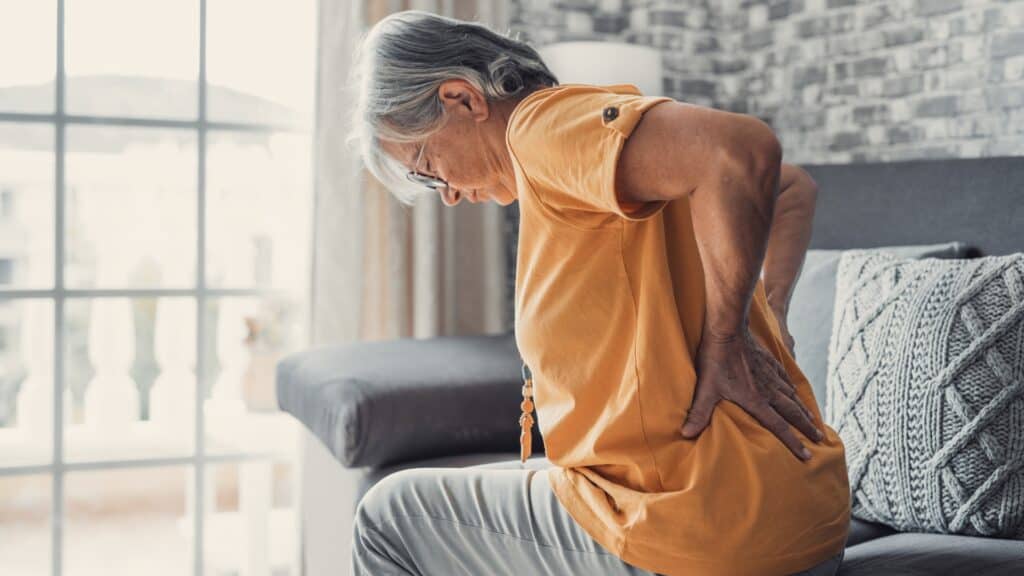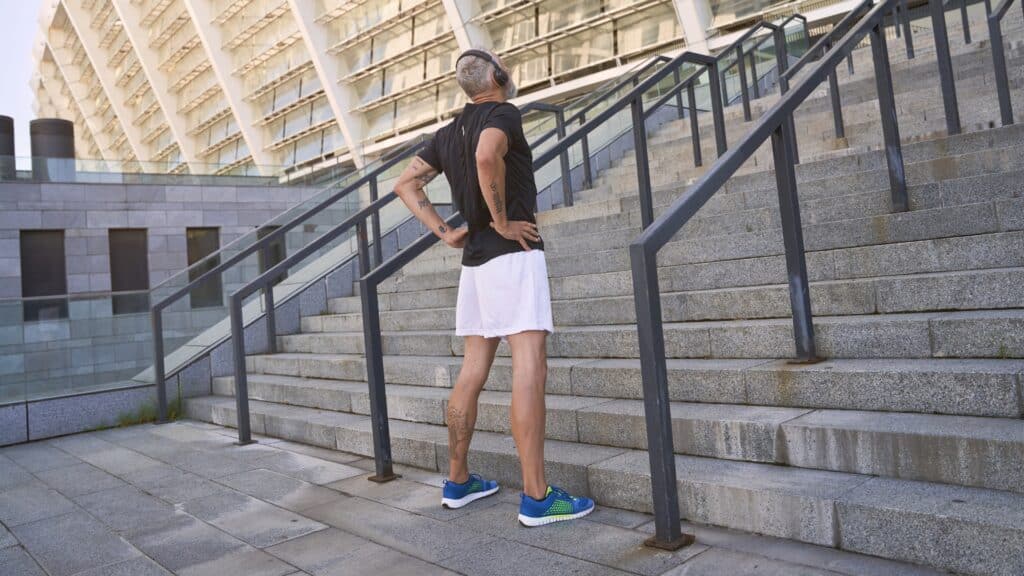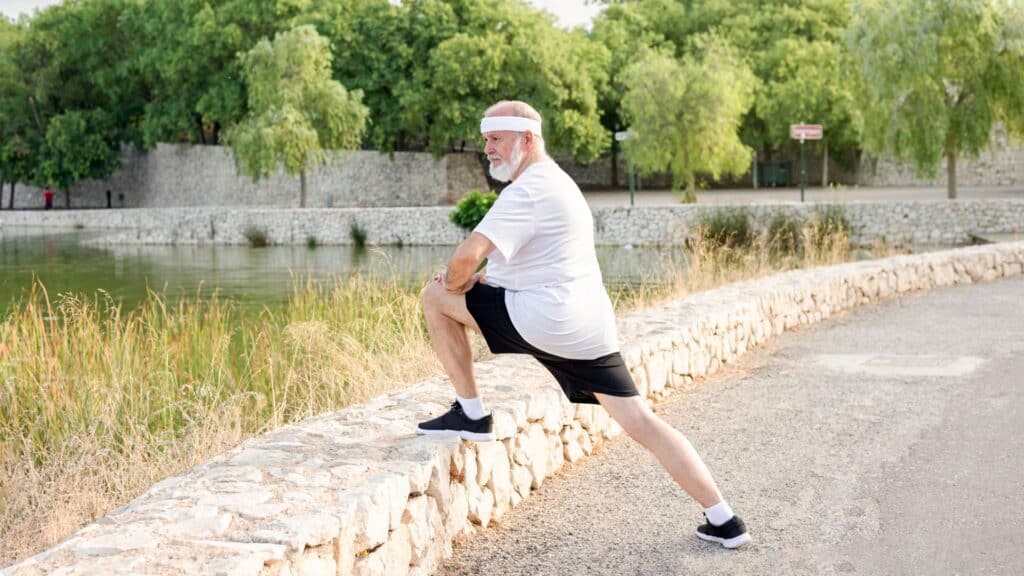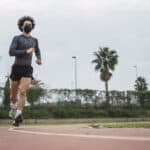As we age, our bones inevitably get weaker, leading to the development of osteoporosis in some individuals.
This is a condition that makes bones brittle and fragile, leading to a higher risk of fractures and breaks. For runners over 50, osteoporosis can seriously impact their ability to exercise and stay fit.
In this post, we will discuss what osteoporosis is, how it impacts runners, and some tips for staying active and healthy while managing this condition.

What is Osteoporosis?
Osteoporosis is a medical condition characterized by the gradual weakening of bones, leading to reduced bone density and an increased susceptibility to fractures.
It occurs when the balance between bone formation and bone resorption becomes disrupted, causing bones to lose their structural integrity and strength.
Typically, bone tissue undergoes a continuous process of renewal, with old bone being broken down by specialized cells called osteoclasts and new bone being formed by osteoblasts. However, this delicate equilibrium is disturbed in individuals with osteoporosis, resulting in a net loss of bone mass over time.
The diminished bone density characteristic of osteoporosis makes bones more porous and fragile, similar to the structure of a honeycomb. This makes them more prone to fractures, even from minor stresses or injuries that wouldn’t normally be a problem for healthy bones. The spine, hips, and wrists are common areas where these fractures occur. Osteoporosis is often called “the silent disease” because it doesn’t have any symptoms in the early stages.
Unfortunately, many people only notice they have it after they experience a fracture or break, which can have a big impact on their mobility and quality of life.
What Are The Causes of Osteoporosis?
Your bones are constantly renewing—new bone is made, and old bone is broken down. In your younger years, your body creates new bones faster than it breaks down the old ones, increasing bone mass.
This process slows down after your early 20s and most people reach their peak bone mass by age 30. As you age, bone mass is lost faster than it’s created.
Risk Factors
Several factors can increase the likelihood of developing osteoporosis, including age, race, lifestyle choices, and medical conditions.
Hormone Levels
Osteoporosis is more common in individuals with imbalances in certain hormones, including sex hormones (estrogen and testosterone) and issues with the thyroid, parathyroid, and adrenal glands.
Unchangeable Risks
Some risk factors are beyond your control, such as:
1. Age: The older you get, the greater the risk.
2. Family History: Having a parent or sibling with osteoporosis increases the risk.
3. Body Frame Size: Smaller body frames may have less bone mass to draw from as they age.
4. Race: Higher risk for white or Asian individuals.
5. Sex: Women are more likely to develop osteoporosis than men.
Medical Problems
Certain medical conditions increase osteoporosis risk, including celiac disease, inflammatory bowel disease, kidney or liver disease, cancer, multiple myeloma, and rheumatoid arthritis.
Dietary Factors
Certain dietary factors contribute to osteoporosis, such as:
1. Low Calcium Intake: Lifelong deficiency in calcium can lead to diminished bone density and increased fracture risk.
2. Eating Disorders: Severely restricting food intake weakens bones in both men and women.
3. Gastrointestinal Surgery: Procedures reducing stomach size or removing part of the intestine limit nutrient absorption, including calcium.
Lifestyle Choices
Certain habits can increase osteoporosis risk:
1. Sedentary Lifestyle: Prolonged sitting increases risk.
2. Excessive Alcohol Consumption: Regularly drinking more than two alcoholic drinks a day raises the risk.
3. Tobacco Use: The role of tobacco in osteoporosis isn’t clear, but it likely contributes to weakened bones.
Steroids and Other Medicines
Long-term use of corticosteroid medicines like prednisone interferes with bone rebuilding. Medications used for seizures, gastric reflux, cancer, and transplant rejection can also contribute to osteoporosis.

What Are The Symptoms of Osteoporosis?
Symptoms of osteoporosis may not be evident in the early stages of bone loss. However, once the bones are weakened, signs and symptoms can include:
- Back pain: Caused by a broken or collapsed bone in the spine.
- Loss of height: Over time, individuals may experience a reduction in height.
- Stooped posture: Osteoporosis can contribute to a forward curvature of the spine, leading to a stooped or hunched posture.
- Increased susceptibility to fractures: Bones become more fragile and break more easily than expected, even with minor stresses or falls.
Complications of Osteoporosis: Bone Breaks
Osteoporosis poses a significant risk of bone breaks, with the most severe complications occurring in the spine or hip. These breaks can have profound consequences:
Hip Fractures:
- Often caused by a fall, hip fractures can lead to disability and an increased risk of death within the first year post-injury.
- Result in considerable impairment of mobility and independence.
Spinal Fractures:
- Occur in the vertebrae, the bones forming the spine.
- May happen without a fall, as weakened vertebrae can collapse.
- Consequences include back pain, loss of height, and a hunched-forward posture.
These fractures underscore the serious impact of osteoporosis on bone health and overall well-being. Preventive measures, including a bone-healthy lifestyle and medical interventions, are crucial in reducing the risk of such complications.
How To Support Bone Health
Maintaining healthy bones is crucial throughout life, and good nutrition and regular exercise are key to preventing osteoporosis.
Vitamin D
- Enhances calcium absorption and supports overall bone health.
- Sunlight provides vitamin D, but dietary sources include cod liver oil, trout, salmon, fortified milk, and cereal.
- The recommended daily intake is at least 600 international units (IU), rising to 800 after age 70.
- For those with limited sun exposure, especially indoors or with sunscreen use, vitamin D supplements may be necessary, with most multivitamins containing 600-800 IU and a safe daily limit of 4,000 IU.
Calcium
- Individuals aged 18 to 50 need 1,000 milligrams of calcium daily, which increases to 1,200 milligrams for women at 50 and men at 70.
Exercise
- Regular exercise aids in building strong bones and slowing bone loss.
- Initiating exercise, especially weight-bearing and balance exercises, at a young age and maintaining it throughout life maximizes benefits.
- Strength training targets muscles and bones in the arms and upper spine, while weight-bearing exercises like walking, running, and sports impact bones in legs, hips, and lower spine.
- Balance exercises such as tai chi reduce the risk of falling, which is particularly important with aging.

Recommendation for Supplements in Areas with Insufficient Sunlight
In areas with limited sunlight or for individuals facing challenges in sun exposure, vitamin D supplements offer a valuable solution. Here’s why:
Bridge the Gap
- Supplements bridge the gap between dietary vitamin D intake and the body’s requirements.
- Ensures optimal calcium absorption and bone mineralization.
Vulnerable Populations
- It is vital for vulnerable populations, like the elderly or those with limited outdoor activities.
- Supports bone health in conditions where sunlight exposure is insufficient.
Consultation is Key
- Consult healthcare professionals for personalized advice on vitamin D supplementation.
- Appropriate dosage is crucial, as excessive intake can have adverse effects.
Effective Bone Health Support
- When used judiciously, supplements become an effective strategy for bolstering bone health.
- It is especially beneficial in regions or circumstances where natural sunlight exposure is a challenge.
Prioritizing vitamin D through supplements, guided by professional advice, ensures a proactive approach to maintaining robust bone health, particularly in situations where sunlight may not suffice.
Comparison of Osteoporosis Prevalence with Breast Cancer in Women
Breast cancer has always been a major health issue that has gained a lot of attention over the years. However, it is crucial to note that osteoporosis affects more women than breast cancer does.
This fact emphasizes the importance of raising awareness about osteoporosis and taking proactive measures to safeguard women’s bone health. As stated above, osteoporosis can lead to fractures, especially in the hip, spine, and wrist, and it can cause chronic pain, disability, and even death in severe cases.
As such, it is essential to prioritize bone health, especially for women, who are more prone to developing osteoporosis due to hormonal changes during menopause and other factors.
By educating ourselves and others about the risk factors, prevention, and treatment of osteoporosis, we can minimize its impact and maintain healthy bones throughout our lives.

Bones Need Proper Nutrition and Strength Training
As already discussed, maintaining proper nutrition is essential for the overall health of our bones, which requires an adequate intake of essential elements like calcium and vitamin D.
However, it’s not just about maintaining a balanced diet; strength training is equally important. Strength training can be likened to the “load” that bones require to stay healthy.
But not just any load will do; targeted resistance training is essential to promote bone density and overall skeletal strength. In other words, it’s the kind of exercise that stresses the bones and muscles, encouraging them to adapt and become stronger. Therefore, incorporating strength training into your fitness routine can help prevent bone loss, maintain bone density, and improve overall skeletal health.
It’s important to take care of your bones, even if you’ve previously neglected them. The good news is that it’s never too late to start improving their health. By incorporating strength training and proper nutrition into your routine, you can actively work to revitalize your bone health.
Osteoporosis can significantly impact runners over 50, but with proper management, it is possible to stay healthy and active. Incorporating strength training, calcium, and vitamin D into your diet, adjusting your training, and taking steps to prevent falls can all help reduce the risk of fractures and keep you on track to reaching your fitness goals.
Always listen to your body and consult your doctor before making any significant changes to your exercise routine.



Comments are closed.